As customer expectations continue to evolve and tech innovations change the loyalty landscape, it’s more important than ever for brands to understand the dynamics driving brand loyalty and engagement so they can keep their customers connected and invested.
That’s why we took a deep dive into Merkle’s 2024 Loyalty Barometer Report, which surveyed 1,500 consumers on their attitudes toward loyalty programs. From AI and privacy concerns to key participation drivers and engagement best practices, we read the report so you don’t have to!
Let’s delve into the findings and explore how businesses can leverage these insights to build lasting customer loyalty.
Product Over Promo
While loyalty programs continue to grow in popularity, Merkle’s research indicates having a great product is the most important factor for consumers in building brand loyalty.
Popularity & Impact
More consumers are participating in loyalty programs than ever before. Over three-quarters of consumers belong to up to five loyalty programs, with 93% recently earning a reward.
These loyalty programs continue to impact behavior, with four out of five consumers making purchases more frequently because of their participation in a loyalty program. They’re also more likely to spend (76%), engage with (43%), and advocate for the brand (61%).
Key Participation Drivers
Not surprisingly, discounts are far and away the top reason consumers participate in a loyalty program (48%), followed by free products (22%). When slicing the data by generation, discounts are more important to Gen X and Baby Boomers, while free products are driving Gen Z to participate.
But discounts alone aren’t enough. Brands need to pair discounts and freebies with soft incentives like surprise offers, exclusive benefits, and personalized experiences to create program stickiness, enhance customer connections, and add value beyond discounts.
Best Ways to Engage:
- Surprise me with offers or gifts (61%)
- Convenience (51%)
- Customized recommendations (36%)
As one of the largest and most successful loyalty programs to date, Chipotle Rewards employs a wide range of these soft incentives to gamify their loyalty program and keep 33M+ rewards members continuously engaged. Since partnering with Sparkfly, Chipotle has generated $3.5B in digital sales (2023), with 111M+ total offers redeemed since 2017.
Creating a Seamless Experience
One of the biggest challenges for brands executing loyalty programs is the fragmented nature of customer engagement. According to Merkle’s research, consumers perceive email communications as part of loyalty programs, meaning brands need to have integrated channel strategies.
An omnichannel loyalty program offers many benefits, including a seamless customer experience, centralized data source for analysis, and the ability to personalize offers (a key factor driving business growth).
Bojangles, for example, partnered with Sparkfly to overhaul its digital engagement strategy and integrate the brand’s digital ordering channels with its offer management platform to connect the entire digital customer engagement experience. Since joining forces with Sparkfly, Bojangles has seen nearly a 500% increase in loyalty program participation and a 158% increase in mobile orders. Not too shabby!
Improving Personalization
With roughly 60% of consumers saying they’re likely to respond to personalized messaging, that leaves a third of consumers currently immune to personalization tactics, leaving the door open for brands to improve their personalized marketing messages and nudge those neutral consumers into gear.
However, increasing concerns around data privacy mean brands need to be careful with their customer data and explain when and how they use personal data to enhance the shopping experience.
Understanding consumer preferences, leveraging data insights effectively, and prioritizing personalized experiences are essential for brands building lasting customer loyalty in 2024. By aligning loyalty programs with evolving consumer mindsets and preferences, brands can create meaningful connections that drive long-term engagement and advocacy.

